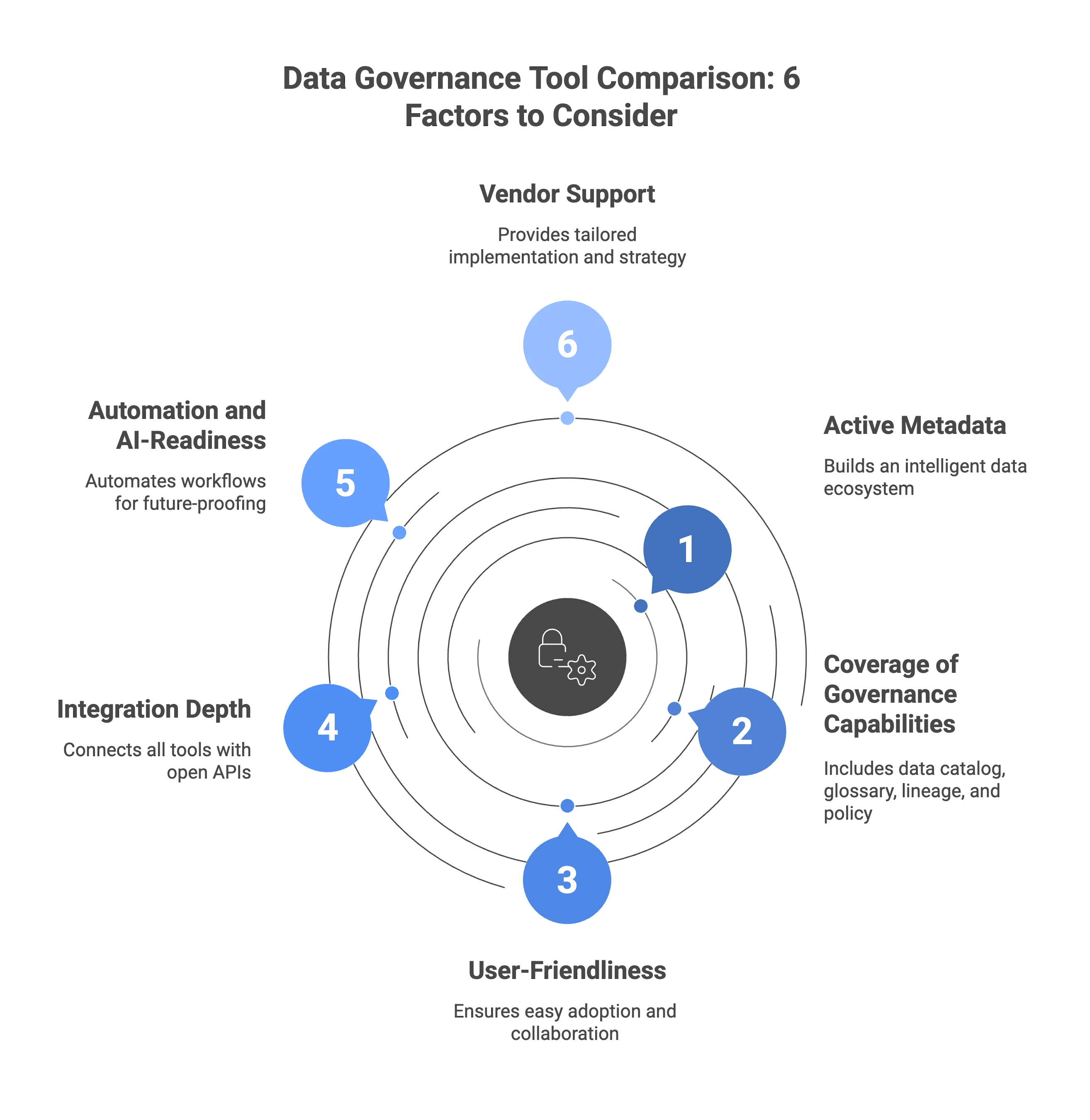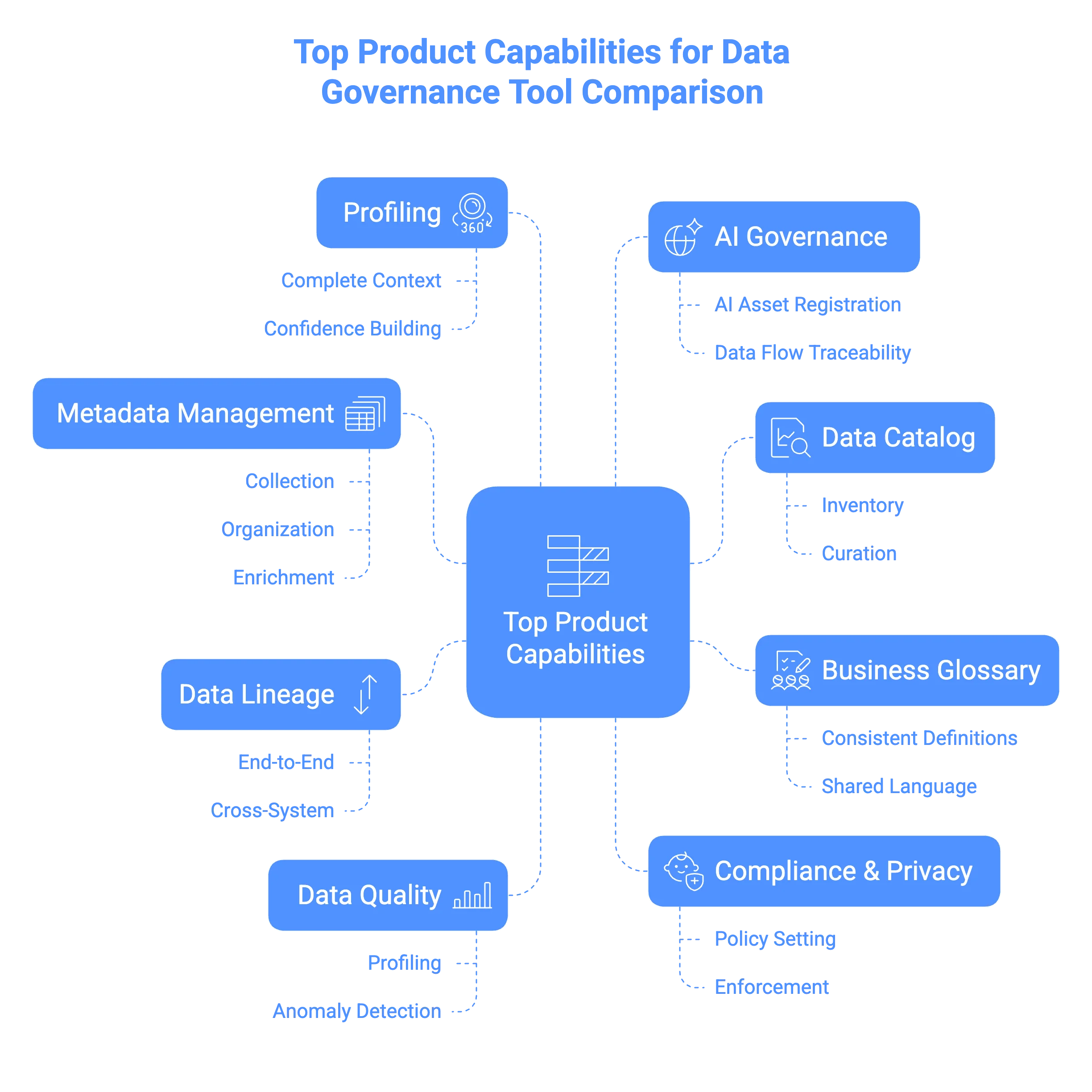Data Governance Tool Comparison: Which Tool Is The Best Business Fit For You in 2025
What are the key factors for data governance tool comparison?
Permalink to “What are the key factors for data governance tool comparison?”Choosing the right governance tool isn’t about ticking checkboxes. It’s about ensuring the platform you pick can embed governance into daily workflows and keep pace with your data strategy for years ahead.
Here’s what to evaluate in depth.

Data governance tool comparison factors - Image by Atlan.
Active metadata
Permalink to “Active metadata”Static catalogs are dead. Modern governance depends on active metadata—metadata that is continuously ingested, enriched, and propagated across tools.
This allows governance policies to flow automatically through lineage, access rules, and dashboards. Ask the following questions:
- Does the tool refresh metadata in real time, or in batch exports?
- Can it propagate changes (e.g., a PII tag) downstream automatically?
- Does it enrich metadata with usage, quality, and business context?
Active metadata makes governance effective by providing rich context and driving scalability, which is crucial for adoption and AI-readiness.
Coverage of governance capabilities
Permalink to “Coverage of governance capabilities”Gartner’s 2025 Magic Quadrant for D&A Governance Platforms underscores the importance of a unified platform with a consistent architecture, rather than siloed solutions for various data governance aspects.
A true governance platform should cover the full governance lifecycle:
- Data catalog & discovery: Central, searchable inventory of assets.
- Business glossary: Shared definitions and relationships.
- Lineage: End-to-end traceability across systems.
- Policy & access management: Rules embedded directly into workflows.
- Data quality: Profiling, anomaly detection, dashboards.
- Compliance: Evidence, audit trails, regulatory mapping.
User-friendliness & adoption
Permalink to “User-friendliness & adoption”A governance tool that no one uses becomes expensive shelfware. Adoption is the difference between compliance on paper and governance in practice.
That’s why poor adoption is the biggest failure mode for governance programs. Tools must work where people already work and adapt to different personas.
So, evaluate:
- Can business users (not just engineers) find and understand data?
- Is collaboration embedded into everyday tools like Slack, Jira, ServiceNow, Looker, or Tableau?
- Does it offer role-based views (executives, analysts, engineers)?
Integration depth
Permalink to “Integration depth”Shallow integrations force manual work and break lineage. An open architecture with deep, API-first integrations build trustable end-to-end visibility and extensibility.
Look for:
- Native connectors: Extending across cloud warehouses, lakes, BI, orchestration (Snowflake, Databricks, BigQuery, Kafka, dbt, Tableau, Power BI, etc.)
- Bidirectional metadata flow: Not just ingesting metadata but pushing policies, tags, and lineage back into source systems.
- Open APIs: So governance can extend to custom apps and future tools.
Automation & AI-readiness
Permalink to “Automation & AI-readiness”Manual governance cannot scale to meet AI governance needs, multi-cloud environments, constantly updating regulations.
For governance to keep pace with exploding data and AI initiatives, evaluate:
- Automated lineage capture, classification, and policy propagation.
- Auto-tagging sensitive data (PII, PCI, PHI) with rule-based + AI patterns.
- Support for AI governance by registering AI/ML models, tracking training datasets, documenting explainability and risk.
Bottom line: The best tools go beyond “catalogs” and become control planes—unifying metadata, governance, and collaboration in one active layer.
Partner, not vendor approach
Permalink to “Partner, not vendor approach”The right provider acts as a partner, tailoring implementation to your business needs and governance strategy. A true partner will:
- Customize onboarding to fit your maturity stage and architecture (e.g., data mesh, data fabric).
- Support adoption with training, documentation, and knowledge-sharing.
- Drive culture change, ensuring the tool delivers ongoing value instead of becoming shelfware.
This partnership mindset future-proofs your governance investments and helps scale adoption across business and technical teams.
What are the top product capabilities to look for in data governance tools?
Permalink to “What are the top product capabilities to look for in data governance tools?”The most important product capabilities in data governance platforms include (but aren’t limited to):
- Metadata management: Ability to collect, organize, enrich, and activate metadata across systems to activate your data estate.
- Data catalog: Inventory and curate data assets with a one-stop-shop – Google for your data estate.
- Business glossary: Align teams on consistent definitions (for assets, domains, data relationships) and develop a shared language across your organization. Gartner recommends looking for the ability to “identify relationships between data elements, synonyms and support ontologies and semantic relationships (business metadata).”
- Data lineage: End-to-end, cross-system, column-level lineage that is actionable and supports root cause and impact analysis. According to Gartner, it must “audit all the steps, applications and transformations that any data element has gone through from its original source to all the possible endpoints.”
- Data quality: Profiling, anomaly detection, and dashboards to monitor accuracy, completeness, and timeliness. Fit-for-purpose data is central to ensuring AI-readiness of your data estate.
- Compliance & privacy: Policy setting and enforcement, sensitive data tagging, audit logs, access management, and auditability support.
- Profiling: Get 360° visibility for each data asset to get complete context and build confidence in your data estate.
- AI governance: A single, unified view of every AI app and model in your enterprise. Look for AI asset registration, data flow traceability, AI asset versioning, policy management, and compliance readiness.

Top data governance product capabilities for tool comparison - Image by Atlan.
What are some common pitfalls to avoid when selecting the best data governance tool for your organization?
Permalink to “What are some common pitfalls to avoid when selecting the best data governance tool for your organization?”Even with a scoring framework, organizations often fall into traps when evaluating governance tools. These pitfalls can derail adoption, waste resources, or lead to compliance gaps.
So, avoid:
- Over-focusing on features, ignoring adoption
- Underestimating integration complexity
- Treating governance as “one-and-done”
- Ignoring the TCO (Total Cost of Ownership)
- Failing to map the data governance tool to business outcomes
- Ignoring the documentation of exit criteria up front – lacking critical integrations, not meeting adoption targets in the pilot, etc.
How can you pick the right data governance tool in 2025? A step-by-step guide
Permalink to “How can you pick the right data governance tool in 2025? A step-by-step guide”Step 1: Define what success looks like with outcomes and guardrails.
Permalink to “Step 1: Define what success looks like with outcomes and guardrails.”Set 3–5 business outcomes and success metrics. Avoid chasing features.
Ask: What are we solving for?
Examples:
- Reduce duplicated metrics
- Clarify KPI definitions
- Improve access control
- Enable faster onboarding
Connect each desired outcome to business impact (e.g., save analyst hours, reduce audit risk, improve campaign ROI).
Prerequisite: Complete a data governance readiness assessment and map your maturity stage. Also, here’s a list of the eight essential data governance objectives to get you started.
Step 2: Define personas and use cases
Permalink to “Step 2: Define personas and use cases”Governance tools must support how people actually work — not how we hope they will. So, ensure that you:
- Map personas across the data lifecycle: data engineers (ingestion/transformation), analysts (analysis/reporting), stewards (quality/ownership), business users (consumption).
- Use the question: “Who touches data, and when?”
- Document top use cases per persona: e.g., audit readiness, campaign performance, customer 360, forecasting.
Choose tools that support persona-specific workflows (e.g., glossary for analysts, lineage for engineers).
Step 3: Run a time-boxed pilot with heavy vendor involvement.
Permalink to “Step 3: Run a time-boxed pilot with heavy vendor involvement.”Keep the pilot measured, and ensure that it’s led by the vendor. Measure time to first value, assets onboarded, and user actions completed.
Capture TCO (admin effort, vendor fees) and ROI (audit prep hours saved, time-to-insight).
Step 4: Test adoption with business users.
Permalink to “Step 4: Test adoption with business users.”The best tools are usable without training. So, involve your entire data governance council and team in observing and testing user adoption–stewards, analysts, and engineers.
For instance, have:
- Data engineers to evaluate lineage, impact analysis, tagging APIs
- Analysts to try search, glossary lookup, asset certification
- Stewards to test workflows, ownership tagging, glossary contributions
Ask: Can they use this tool without reading a manual? If the answer is no, then the tool isn’t a fit. Confusing UX is a top cause of failed adoption.
Step 5: Ensure the tool closes the context gap.
Permalink to “Step 5: Ensure the tool closes the context gap.”Most enterprises today struggle with the AI Value Chasm — the gap between successful AI pilots and failed production rollouts. Bridging this chasm requires:
- Unified context across systems – CRMs, warehouses, SharePoint, Slack, and more.
- Shared business language embedded within every workflow.
- Automated and active governance to scale your implementation efforts.
So, when comparing data governance tools, you should check how they:
- Handle scaling metadata (millions of assets)
- Support AI readiness (e.g., feeding lineage to AI agents)
- Provide automated compliance frameworks (BCBS, GDPR, etc.)
- Enable domain-based governance for federated teams
Ask your data governance partner how they’ll help you move from governance for documentation → to governance for AI, automation, and self-service.
Step 6: Plan rollout and change management.
Permalink to “Step 6: Plan rollout and change management.”Document a 90-day implementation roadmap. Include data domains in scope, owner and steward assignments, adoption goals, training, and communications.
Bottomline: Don’t buy a tool, but a working model.
Permalink to “Bottomline: Don’t buy a tool, but a working model.”Tools are only 1 part of the equation. Make sure your vendor can also support:
- Change management
- Governance operating model design
- Enablement playbooks
- Persona-specific adoption strategies
Let the tool fit your people, not the other way around.
Real stories from real customers: Ensuring data governance success and unlocking value creation
Permalink to “Real stories from real customers: Ensuring data governance success and unlocking value creation”
Building branded shopping experiences with a collaborative data workspace
“I liked the sales approach of Atlan. Generally speaking, I didn’t find the team to be pushy or “salesy”. It was more like “This is our tool. We know what we’re about, we stand behind what we have, and we want to work with you as a partner.” I like working with companies like that.”
Ted Andersson, Director of Business Intelligence
CouponFollow
🎧 Listen to AI-generated podcast: How CouponFollow Leveraged Active Metadata
Join Data Leaders Scaling with Automated Data Governance
Book a Personalized Demo →
Improved time-to-insight and reduced impact analysis time to under 30 minutes
“I’ve had at least two conversations where questions about downstream impact would have taken allocation of a lot of resources. actually getting the work done would have taken at least four to six weeks, but I managed to sit alongside another architect and solve that within 30 minutes with Atlan.”
Karthik Ramani, Global Head of Data Architecture
Dr. Martens
🎧 Listen to AI-generated podcast: Dr. Martens’ Journey to Data Transparency
Join Data Leaders Scaling with Automated Data Governance
Book a Personalized Demo →Ready to choose the best data governance tool for your organization?
Permalink to “Ready to choose the best data governance tool for your organization?”The best data governance tool isn’t the one with the longest feature list, but the one your teams will actually use.
Decision-makers should prioritize automation, adoption, user-friendliness, extensibility, and integration depth over heavyweight checklists.
A modern context layer for humans and AI like Atlan unifies context across systems, drives collaboration on meaning, and activates context in every workflow.
Let us help you build it
Book a Personalized Demo →FAQs about data governance tool comparison
Permalink to “FAQs about data governance tool comparison”1. What is the best data governance tool?
Permalink to “1. What is the best data governance tool?”There’s no single “best” tool — the right choice depends on your organization’s size, regulatory needs, data stack, and culture. Atlan leads the category and is a top customer choice according to Gartner as it excels in active metadata, embedded collaboration, and innovation.
2. What should you look for in a data governance tool?
Permalink to “2. What should you look for in a data governance tool?”Key factors to evaluate include:
- Active metadata (always-on, context-rich governance)
- Coverage (catalog, glossary, lineage, policy enforcement, quality, compliance)
- Ease of adoption (intuitive UI, collaboration, self-service)
- Integration depth (connectors, APIs, bi-directional sync)
- Automation and AI-readiness (classification, lineage, monitoring at scale)
- Partner, not vendor approach (custom implementation to fit your business needs)
3. What is the difference between Atlan and Collibra?
Permalink to “3. What is the difference between Atlan and Collibra?”Atlan: A modern, active metadata platform focused on automation, real-time lineage, and embedded collaboration. Known for speed of deployment and user adoption across business and technical teams.
Collibra: A traditional governance suite with strong policy workflows, approval chains, and compliance tracking, but often criticized for being heavier to deploy and less intuitive for business users.
4. Which data governance tool is known for its metadata management capabilities?
Permalink to “4. Which data governance tool is known for its metadata management capabilities?”Atlan is the only tool that activates metadata and bridges the context gap for humans and AI – across data, business meaning, and governance for your entire data ecosystem. To see the business value yourself, book a personalized demo today.
5. How do you measure ROI when selecting a data governance tool?
Permalink to “5. How do you measure ROI when selecting a data governance tool?”Look at tangible outcomes such as:
- Reduced audit prep time (measured in weeks or months saved).
- Faster data discovery and access requests (hours vs. minutes).
- Lower compliance costs (fewer fines, reduced manual effort).
- Improved time-to-insight for analytics and AI projects.
6. What are the common pitfalls in tool selection?
Permalink to “6. What are the common pitfalls in tool selection?”Avoid:
- Choosing tools based only on feature checklists.
- Treating governance as “one-and-done”
- Underestimating integration complexity with your data stack.
- Ignoring user adoption and ease of use.
- Overlooking automation and AI-readiness for future needs.
- Failing to tie capabilities back to audit and compliance outcomes.
- Failing to establish exit criteria up front.
Share this article
Atlan is the next-generation platform for data and AI governance. It is a control plane that stitches together a business's disparate data infrastructure, cataloging and enriching data with business context and security.
Data governance tool comparison: Related reads
Permalink to “Data governance tool comparison: Related reads”- Data Governance in Action: Community-Centered and Personalized
- Data Governance Framework — Examples, Templates, Standards, Best practices & How to Create One?
- Data Governance Tools: Importance, Key Capabilities, Trends, and Deployment Options
- Data Governance Tools Comparison: How to Select the Best
- Data Governance Tools Cost: What’s The Actual Price?
- Data Governance Process: Why Your Business Can’t Succeed Without It
- Data Governance for AI: Challenges & Best Practices
- Data Governance Maturity Model: A Roadmap to Optimizing Your Data Initiatives and Driving Business Value
- Federated Data Governance: Principles, Benefits, Setup
- Data Governance Committee 101: When Do You Need One?
- Data Governance Policy: Examples, Templates & How to Write One
- 7 Best Practices for Data Governance to Follow in 2025
- Benefits of Data Governance: 4 Ways It Helps Build Great Data Teams
- Key Objectives of Data Governance: How Should You Think About Them?
- Principles of Data Governance: Pillars of a Modern Data Culture
- 7 Must-Have Data Governance Certifications for 2025
- How to Drive Business Value with Data Governance
- Data Governance Roles & Responsibilities: A Quick Round-Up
- How to Build A Data Governance Team
- Data Governance Councils in 2025: Everything You Need to Know























